iBusiness
Vol.3 No.2(2011), Article ID:5459,8 pages DOI:10.4236/ib.2011.32027
Are the Criteria for Health and Safety Available in Adjustable Saudi School Furniture?
![]()
Industrial Engineering Department, King Saud University, Riyadh, Saudi Arabia.
E-mail: {kalsaleh, mramadan1}@ksu.edu.sa
Receive April 10th, 2011; revised May 13th, 2011; accepted May 18th, 2011.
Keywords: School Furniture, Discomfort Scale, Human Factors, EMG, Furniture Design, Anthropometry
ABSTRACT
This research investigated the effect of adjustable Saudi chair-table combinations available in the local market on the student’ health and safety. Thirty seven young students participated in this research. Ten chair-table combinations, within three different activities (reading, writing, and looking at the blackboard), were the independent variables. Normalized discomfort ratings, and neck dorsal and upper trapezius muscular activities were the dependent variables. Variances among students’ body dimensions and classroom furniture were also studied. There were higher levels of neck dorsal and upper trapezius muscular contractions associated with less dimensions of chair-table combinations compared to high dimensions of chair-table combinations. Normalized discomfort ratings at the neck, shoulder, thigh, and feet were significantly higher at high chair-table dimensions. Matched school furniture to the student dimensions was associated with low dimensions of chair-table combinations. The suitability of the local adjustable chair-table combination was not fit to the students’ health. Saudi furniture industry should review and provide the local schools with the most appropriate furniture to Saudi students’ anthropometric dimensions.
1. Introduction
The sitting position proved to be a troublesome situation in connection with musculoskeletal discomfort and low back pain [1-3]. This is of great importance because the strongest predictor of having future back pain is a previous history of such symptoms [4]. This situation has a great impact on direct and indirect medical care costs [5]. In Saudi Arabia, children use school furniture extensively during a vital period of human physical development. Therefore, the suitability of school furniture for the users is very critical since school children might spend 30% of their waking hours at school [6] and about 5 hours of their school days in sitting postures [7].
It is noted that schoolchildren are expected to sit most of the school time on furniture that is often too large or too small [8]. When the chair is too high, for example, the soles of the feet do not have proper contact with the floor surface and the underside of the thigh becomes compressed causing discomfort and restriction in blood circulation. This situation forces the student to move his buttocks forward on the chair seat. This can result in a slumped, kyphotic posture due to lack of back support. However, when the chair is too low, the knee flexion angle becomes small, the student’s weight is transferred to a small area of the ischial tuberosities and there is a lack of pressure distribution over the posterior thighs [9].
Unfortunately, in most developed and undeveloped countries school furniture is poorly designed [10]. Poor design includes low quality, and is often unfit for school use, yet it is expensive and consumes a disproportionate share of limited educational budget. Schools have the opportunity to contribute to musculoskeletal health using workstations that meet children’s anthropometric requirements [11].
Generally, this problem of poor furniture design can be solved using either a good lumbar support or an increase in the trunk-thigh angle [12]. The seat should have a forward inclination of approximately 5°, and the height of the table should normally correspond to the elbow height plus 3 - 5 cm. Moreover, the table should have a tilted desk with an inclination of 15° [13]. An alternative design proposes a chair with a significant forward tilt of the seat pan combined with a raised and tilted desk with an inclination of 0° - 20° [14]. This chair increases the trunk-thigh angle and, by doing so, it may decrease the load supported by the spine and its musculature.
The major part of the research on the seated working position is focused on the forward leaning posture, probably because of the predominant interest in adult subjects, and their occupations in offices or factories. Therefore, the results obtained from studies on adults cannot automatically be applied to school children. In the school setting, it is quite important to note the different ways of seating through different school activities. Such activities are leaning backward while resting or watching the blackboard, and leaning forward when writing or reading [15].
It is observed that the present school furniture in Saudi Arabia is not adequate in some aspects in which the height of this furniture is approximately 10 cm higher than ISO standard furniture [16]. Therefore, proper chair-table design is essential to facilitate learning by providing a comfortable and stress-free studying station. The proposed chair-table design should provide adequate support for the student, and should allow efficient performance of studying, and also should permit changes in posture, and give comfort to the student. Poor chair-table design (i.e., inadequate to anthropometrical measures of the users, unsuitable for the postural adaptation, and not supporting the most appropriate dimensions of student body) may affect the studying process, lead to student discomfort and dissatisfaction, and aggravate some medical conditions such as back pains [17-19].
It is time to study what is available in our schools provided from the local market furniture. Is it appropriate and safe for all school age groups to use school furniture from the local market? Therefore, an extensive survey was done to the Saudi market to evaluate the available items of school tables and chairs.
This paper has been organized as follows: Method is presented in section two, which consists of participants, surface electromyography activity analysis, subjective measures, variance of classroom furniture and students body dimensions technique, experimental procedure, experimental design, and data analysis. Section three is dedicated for the results. This section includes the results of effects of different chair-table combinations on neck and shoulder muscular activities, and subjective ratings. Finally, discussion and conclusion are in section four.
2. Method
An experiment was performed to study the effect of using different table and chair combinations on neck dorsal and upper trapezius muscular activities. Normalized discomfort ratings as well as variances among students’ body dimensions and classroom furniture were also studied.
School permission, student, and parental agreements were obtained prior to any experiment. Thirty seven participants from elementary schools were employed in the experiment using ten different sets of tables and chairs. In each set, the student performed three different activities. These activities represent the popular activities carried out by the students on a daily basis. The three activities carried out by the students during this experiment were: 1) reading; 2) writing; and 3) looking at the blackboard which is similar to the posture of listening to the teacher in class.
A physician examined all students to ensure that they were free of musculoskeletal injury and pain before participating in the experiment. Participants were excluded from the study if they had any neuromuscular disorders, lower extremity injuries, back problems, or prescriptions for any medication that altered muscle function. The procedures of the whole experiment were introduced to the participants and their parents before conducting the experiments. Human ethical approval, all participant assents, and parent consents were obtained before participating in the study.
Four identical sets of adjustable tables and chairs of the last model were selected for this study as shown in Figure 1. The reason for choosing such types of table and chair combinations was that they were adjustable to four different heights. Those heights were classified as: high, 2nd middle, 1st middle, and low. The dimensions of the chairs and tables are indicated in Table 1. Those four heights formed ten different sets of tables and chairs that were used in this experiment:
SET (1): High chair and high table.
SET (2): High chair and 2nd middle table.
SET (3): 2nd middle chair and 2nd middle table.
SET (4): 2nd middle chair and high table.
SET (5): 2nd middle chair and 1st middle table.
SET (6): 1st middle chair and 1st middle table.
SET (7): 1st middle chair and 2nd middle table.
SET (8): 1st middle chair and low table.
SET (9): Low chair and low table.

Figure 1. Chair-table combination used in the study.

Table 1. Chair and table characteristics.
SET (10): Low chair and 1st middle table.
2.1. Participants
Thirty seven participants were recruited from native Saudi students based on availability. The ages of the students ranged from 7 to 13. They are between 115.8 and 163.5 cm tall and weighed between 20 and 60.5 kg, as shown in Table 2.
2.2. Surface Electromyography Activity Analysis (EMG)
During the tested session, surface electrodes were placed on the target muscles. Those target muscles were neck dorsal muscles (level C2-3) and upper trapezius muscles. Electrode placements were determined based upon the guidelines referenced in previous studies [20,21].
Two pairs of electrodes were attached to the muscle sites, and two common ground electrodes were attached to the bony places where little muscle activity was observed. Muscular activities were recorded using disposable pre-gelled surface electrodes. The electromyography was recorded the results using the average mode, and a bipolar setting of disposable surface electrodes. The signals of the EMG values (in micro-volts) attained were recorded using “CASSY Sensor, Ag/AgCl” and applied in a standardized manner [22], impedance < 20 kΩ. The signals were amplified (Mespec 4000 System, CASSY Lab., Leybold Didactic Gmbh, Germany), band-pass filtered 20 - 500 Hz, A/D converted and sampled at 1000 Hz (CASSY LAB Win 5.0, Leybold Didactic Gmbh, Germany).
A relative muscle activity level, which indicated the differences in the muscle effort in different set numbers, calculated by a simple comparison of the amount of the mean values of the root mean square values [23]. Normalization, e.g., the (Maximum Voluntary Contraction) MVC value, was also described as not required, if a direct comparison was made among different working conditions (doing different activities in all sets in this study keeping electrodes in their positions during whole testing sessions); so long as the electrode positions were identical within the test series [24]. EMG values such as root mean square (RMS) were measured during doing
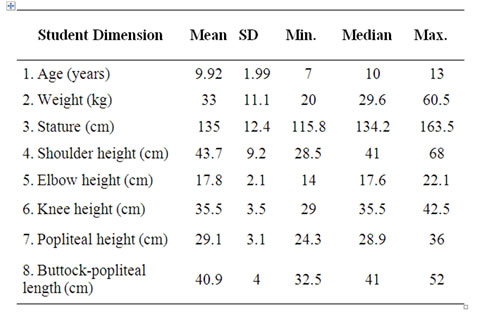
Table 2. A summary information on the student body dimensions for 37 students.
three main studying activities in ten different settings.
2.3. Subjective Measures
During the experiment, the subjects reported their feelings on a rating scale using seven markers. Those markers indicate seven steps of feelings ranging from very relaxed to very tense activities to the hands and arms, neck and shoulders, back, and leg-feet areas. The maximum normalization method was employed using the participant’s maximum response as the reference in order to set the same reference across the participants [25]. The discomfort ratings were divided by the same value assigned for the participant as “very tense” feeling. The method is described as follows:
 (1)
(1)
Where i the participant number (i = 1, 2,…, 37); j the set number (j = 1,…, 10); k the studying activity (k = 1, 2, 3); Yijk the normalized value of the ith participant’s discomfort rating at the jth set number and doing kth activity; Xijk the raw data of the ith participant’s discomfort rating for the jth set number doing kth activity; Maxi the ith participant’s maximum discomfort rating corresponding to “very tense” feeling.
2.4. Variance of Classroom Furniture and Students Body Dimensions Technique
Anthropometric measures of each student were compared to the relative furniture measures in order to identify any variances between the dimensions of the classroom furniture and the dimensions of the student’s body. A mismatch is described as incompatibility between the dimensions of the classroom furniture and the dimensions of the student’s body [26,27].
A mismatch is noticed when the seat height was either >95% or <88% of the popliteal height. A critical mismatch is also noticed when the seat height was either >99% or <80% of the popliteal height. For the purposes of defining a mismatch of the seat height, the student’s popliteal height was adjusted for a shoe height by adding 2.3 cm to the popliteal height. This amount was reached by taking the mean heel height from the 37 participated students’ shoes.
A mismatch in the table/desk height is noticed when a table height is <2 cm higher than the student’s knee height. Furthermore, an acceptable table height is determined by equation (2) [26]:

 (2)
(2)
where:
TDH is the table/desk height;
SH is the seat height;
hE is the vertical distance from the top of the desk to the student’s sitting surface;
hS is the shoulder height;
EH is the elbow height;
U = hS – EH is the upper arm length;
(θ) is shoulder flexion; and
(β) is shoulder abduction.
The minimum and maximum acceptable angles of the shoulder during writing are 0° - 25° for shoulder flexion and 0° - 20° for shoulder abduction [27]. For flexion angles the corresponding cosines are 1 (0°) and 0.9063 (25°) and for abduction angles the corresponding cosines are 1 (0°) and 0.9397 (20°) [27]. Applying the cosines to the equation (2), desk height was determined using equations 3 and 4.
 (3)
(3)
 (4)
(4)
where:
MinTH is the minimum table height;
MaxTH is the maximum table height Since U = hS – EH.
Thus, a mismatch of elbow-shoulder height and desk height is marked when the table is either shorter than the minimum table height or higher than the maximum table height. Thus applying equations (3) and (4), the number and the percentage of the students whose measurements matched, and did not match the furniture dimensions can be determined.
2.5. Experimental Procedure
The study started by asking the students to wear suitable light cloths. The experimenter asked each student to take off his shoes in order to take his weight and several body dimensions to avoid measurement error resulting from possible variations in shoe weight and height.
The experimenter palpated each student’s individual muscle to get precise placement of the EMG electrodes; in addition, the skin surface was prepared by rubbing alcohol to minimize skin resistance due to the presence of dead skin or oil.
To reduce possible order effects due to a repeatedmeasure aspect of the experimental design, the presentation order of the experimental conditions to the subjects was randomized. Each subject passed through the three studying activities in each experimental set within twenty to thirty minutes period without removing the fixed electrodes. The input signals were monitored while the selected muscles contract and relax in order to ensure the highest quality of EMG signals without creating visible noise. Only, one student was observed a day during his studying period and through his normal learning process. During doing the three activities on each set, the questionnaires about discomfort ratings in the back, the neck-shoulder, arm-hand, and leg-feet areas were reported at the end of each experimental trial.
2.6. Experimental Design and Data Analysis
Data analysis, using SPSS for MS Windows 10.0, involved the computation of descriptive statistics as well as multivariate analysis of variance (MANOVA). Normality test was employed to one of these anthropometric measurements (e.g., stature length). An easy way of determining whether the distribution is skewed or not, is to compare the values of the mean and median. For normal distribution, the mean and median are numerically identical, as shown in Table 2. In addition, there were no significant differences between participants’ anthropometric data of this study and the Saudi anthropometrical data published in the literature when the same age group was compared [28]. However, the anthropometric data that was needed to serve in the school furniture design (e.g., popliteal height, popliteal buttock length, etc.) is not available in the literature.
A within-subjects design was used in the form of (A X B X S) to determine the differences in means of the dependent variables’ levels due to the effects of set numbers, studying activities, and subjects’ physical workloads on the subjects’ physiological parameters and normalized discomfort ratings.
3. Results
3.1. Results of the EMG Activity Analysis
Muscular activity was one of the main dependent variables. Two factors that represent the main independent factors are: set numbers and studying activities. The levels of set numbers were ten sets. The levels of studying activities were: reading, writing, and looking at the blackboard. Finally, subjects were within factors. A withinsubject design was implemented. Only root mean square of the EMGs signals for both neck dorsal muscles and upper trapezius muscles were used.
3.1.1. Root Mean Square of the Neck Muscular Activity
The two-order interaction was not significant. However, both main variables had significant effects on neck muscular activities. Figure 2 shows that students’ neck muscular activities were affected significantly by types of table-chair combinations, F(9,324) = 2.04, p < 0.034. As shown in Table 3, the neck muscular activities of sets’ numbers one and two were significantly less stresses than those ones at set number ten (Duncan range test, p < 0.05). However, neck muscular activities at sets’ numbers 5, 6, 4, 3, 8, and 9 were about the same.
Figure 3 shows that students’ neck muscular activities were significantly different at different studying activities, F(2,72) = 34.52, p < 0.000. Neck muscular activity was significantly lower at looking at the blackboard activity than the others (Duncan range test, p < 0.05). In addition, neck muscular activity was significantly higher at writing activity than the others, as shown in Table 3.
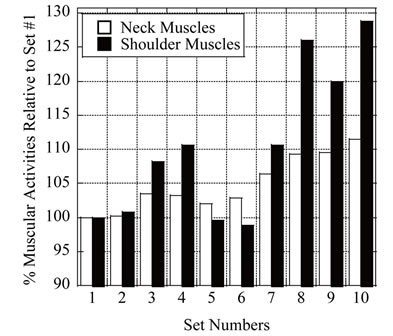
Figure 2. Effect of table and chair combinations on neck and shoulder muscular activities.
3.1.2. Root Mean Square of the Shoulder Muscular Activity
The two-order interaction was not significant. However, both main variables had significant effects on shoulder muscular activities. Figure 2 showed that students’ shoulder muscular activities were affected significantly by types of table-chair combinations, F(9,324) = 12.43, p < 0.000. As shown in Table 3, the shoulder muscular activities of sets’ numbers 6, 5, 1, and 2 were significantly less stress than those ones at sets’ numbers 9, 8, and 10 (Duncan range test, p < 0.05). Furthermore, a shoulder muscular activity at set number 10 was the highest level over all others.
Figure 3 shows that students’ shoulder muscular activities were significantly different at different study
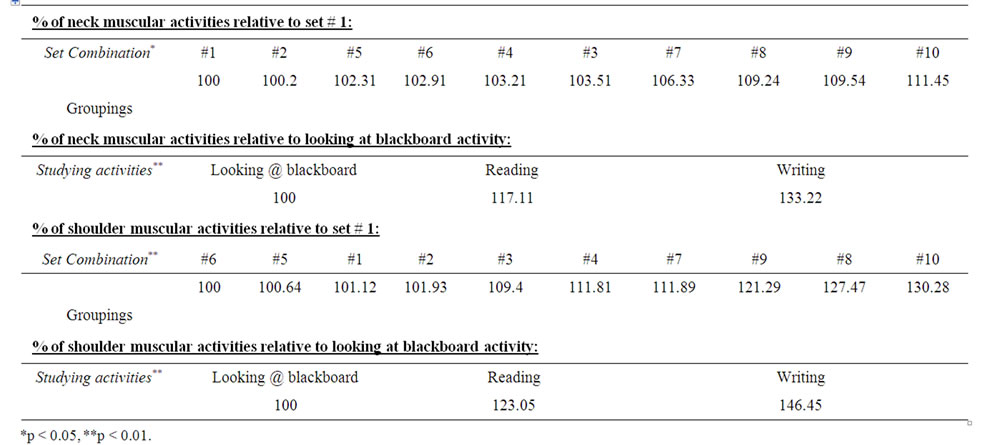
Table 3. Percentage of neck and shoulder muscular activities relative to set # 1, looking at blackboard activity, and their results of Duncan’s multiple rang tests.

Figure 3. Effect of studying activities on neck and shoulder muscular activities.
ing activities, F(2,72) = 33.22, p < 0.000. Shoulder muscular activity was significantly lower at looking at the blackboard activity than the others (Duncan range test, p < 0.05). In addition, shoulder muscular activity was significantly higher at writing activity than the others, as shown in Table 3.
3.2. Results of Subjective Ratings
At the end of each experimental treatment, the subjects were asked to give their feedback in ranges given as very relaxed to very tense (comfortable to discomfort). The grand means of the normalized values of the participants’ discomfort ratings were given in Figure 4. The differences among the table chair combinations were significant (p < 0.05) for arms and hands, neck and shoulders, legs as well as for the back (χ2). At leg areas, the sets number 4, 5, 6, and 7 were associated with more feelings of relaxation than those ones at sets number 1, and 2. Discomfort in arms and hands seem to be lower at sets number 3, 5, and 8 compared to 1, 4, and 10. In addition to the feelings of being relaxed at the neck and shoulder were reported at sets number 3 and 5 compared to sets number 1, 2, and 10; the feelings of being relaxed at the back are reported at sets number 3 and 4 compared to set number 8. In general, relaxation was experienced by the students who had been seated on sets number 3, 4, 5, 6 and 7.
3.3. Results of the Comparison between Student Body Dimensions and Classroom Furniture
3.3.1. Chair Height Analysis
Figure 5 shows the percentage of the students whose measurements highly matched, critically matched, or did not match the dimensions of the chair height. For high chair, 100% of the students’ measurements did not match the proportion to the chair’s height. For 2nd mid chair, 5%, and 95% of the students measurements did critically
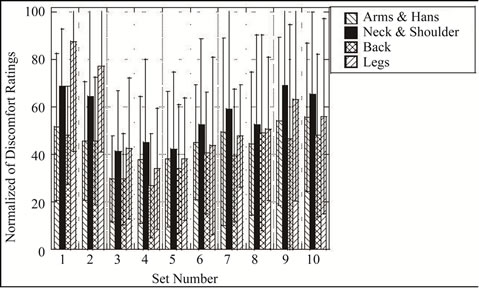
Figure 4. Effect of table and chair combinations on subjective ratings.
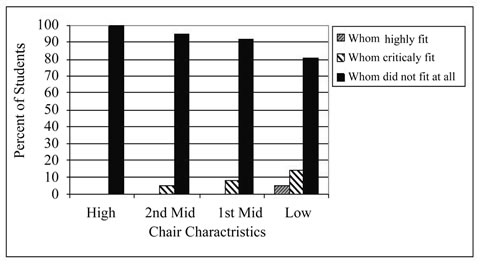
Figure 5. Percentage of the students whose measurements matched or did not matched the chair height dimensions.
match, or did not match the proportion to the chair’s height, respectively. In addition, 8%, and 92% of the students measurements did critically match, or did not match in the proportion to the chair’s height, respectively for 1st chair; 5%, 14%, and 81% of the students’ measurements highly matched, critically matched, or did not match the proportion to the chair’s height, respectively for low chair. These results indicated that with using adjusted chair, the best adjustable chair height might be adjusted to fit only 19% of student population.
3.3.2. Table Height Analysis
Figure 6 shows the percent of the students whose measurements matched or did not match the dimensions of the table heights. The classroom furniture under study consisted of four different sized table heights. Only 8%, 19%, 41%, and 84% of the students’ measurements did match in the proportion to the table’s height for high, 2nd, 1st, and low table heights, respectively. These results indicated that with using adjusted table, the best adjustable table height might be adjusted to fit only 84% of student population.
4. Discussion and Conclusions
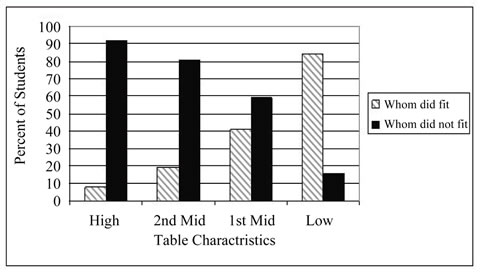
Figure 6. Percentage of the students whose measurements matched or did not matched the table height dimensions.
Based on the analysis of the muscular activities, it is obvious that set number 10 had the highest stresses in terms of dorsal neck muscular contraction as well as upper trapezius muscular contraction. This result agreed with an earlier study [29]. At low furniture level, for example, children push themselves towards the back seats when they were writing or working at the table causing more strains on their lumbar curvatures. Generally, as expected, reading and writing were more stressful than looking at the blackboard or listening to the teacher because of bending their lumbar curvatures. In addition, The EMGs’ signals for both muscles expressed the lowest values within middle set numbers.
The feeling of relaxation was experienced by the student who was seated on sets number 3, 4, 5, 6 and 7 compared to their feeling on sets number 1, 2, 8, 9, and 10. These results indicated that with using adjustable furniture, the best adjustable chair and table heights might be adjusted to fit only 19% and 84% of the student population, respectively. It is very obvious that even with the adjustable furniture available in the local market; there is high level of general body part discomfort associated with many of those table-chair combinations.
Despite the fact that the school can provide all sixgrade classes with those ten combinations, it’s hard for the students to find the chair-table combinations which adequately fit their body dimensions. The conclusions of this study were similar to the results of other studies [1,15,17,26]. Desk and seat height bigger than the accepted limits for most schoolchildren (81.8% and 71.5%, respectively) were reported in the literature [17]. A study found a substantial degree of mismatch between the students' body dimensions and the school furniture that was available to them. Less than 35% of the students were able to find appropriate chair-table combinations [15]. Very high levels (95.85% of the students’ population) of mismatch between students’ popliteal heights and the seat height were also found in the literature. These mismatches were attributable to seats that were too high. A study found that most students are sitting on chairs with seats that are too high or too deep and on desks that are too high [26].
It is recommended to collect a significant anthropometric data of the Saudi students. Then, the design and development of the table-chair combination must follow some standard procedures to present Saudi table and chair standards. In other words, full accommodation which students need would require ergonomically redesigned school furniture. Putting in mind that one set size fit one grade does not accommodate the variability of anthropometry even among children of the same age. Of course, the number of students that were employed in this work was not sufficient for determining the main effects with high level of test power. However, the trend of the conclusion was clearly detected.
Finally, this study tested the suitability of the adjustable school furniture that is available in the local Saudi market. Based on the study results, it is time for Saudi furniture industry to review and provide the local schools with the most appropriate criteria of Saudi students’ anthropometric dimensions.
5. Acknowledgements
The authors would like to thank the participants who made this work possible. Also, the authors would like to express appreciation to the management and administration teams of Riyadh schools, the most kind and lovely people he has ever met.
REFERENCES
- P. Grimes and S. J. Legg, “Musculoskeletal Disorders (MSD) in School Students as a Risk Factor for Adult MSD: A Review of the Multiple Factors Affecting Posture, Comfort and Health in Classroom Environments,” Journal of the Human-Environmental System, Vol. 7, No. 1, 2004, pp. 1-9. doi:10.1618/jhes.7.1
- E. N. Corlett, “Are You Sitting Comfortably?” International Journal of Industrial Ergonomics, Vol. 24, No. 1, 1999, pp. 7-12.
- I. M. Al-Harkan, M. Z. Ramadan, M. A. Sharaf and H. A. Helmy, “Design, Development, and Implementation of School Furniture for Saudi School Students,” Technology Representatives, KACST Project NO. AT-20-49, No. 2, Riyadh, 2002.
- I. M. Al-Harkan, M. Z. Ramadan, M. A. Sharaf and H. A. Helmy, “Design, Development, and Implementation of School Furniture for Saudi School Students,” Final Technology Representatives # 5, KACST Project NO. AT-20-49, Riyadh, 2005.
- J. K. Wingrat and C. E. Exner, “The Impact of School Furniture on Fourth Grade Children’s on-Task and Sitting Behavior in the Classroom: A Pilot Study,” Work, Vol. 25, No. 3, 2005, pp. 263-272.
- J. Pynt, J. Higgs and M. Mackey, “Seeking the Optimal Posture of the Seated Lumbar Spine,” Physiotherapy Theory and Practice, Vol. 17, No. 1, 2001, pp. 5-21. doi:10.1080/09593980151143228
- L. Saarni, C. Nygard, A. Rimpela, T. Nummi and A. Kaukiainen, “The Working Postures among Schoolchildren—A Controlled Intervention Study on the Effects of Newly Designed Workstations,” Journal of School Health, Vol. 77, No. 5, 2007, pp. 240-247. doi:10.1111/j.1746-1561.2007.00199.x
- L. A. Saarni, A. H. Rimpela, T. H. Nummic, A. Kaukiainen, J. J. Salminen and C. Nygard, “Do Ergonomically Designed School Workstations Decrease Musculoskeletal Symptoms in Children? A 26-Month Prospective Follow-Up Study,” Applied Ergonomics, Vol. 40, No. 3, 2009, pp. 491-499. doi:10.1016/j.apergo.2008.09.011
- C. Joanne and T. Wong, “Anthropometric Evaluation for Primary School Furniture Design,” Ergonomics, Vol. 50, No. 3, 2007, pp. 323-334. doi:10.1080/00140130600842328
- M. Marschall, A. Harrington and J. Steele, “Effect of Work Station Design on Sitting Posture in Young Children,” Ergonomics, Vol. 38, No. 9, 1995, pp. 1932-1940. doi:10.1080/00140139508925241
- A. C. Mandal, “The Correct Height of School Furniture,” Human Factors, Vol. 24, No. 3, 1982, pp. 257-269.
- N. B. Diep, “Evaluation of Fitness between School Furniture and Children Body Size in Two Primary Schools in Haiphonh, Vietnam,” Master’s Thesis, Department of Human Work Sciences, Lulea University of Technology, 2003.
- British Standards Institution, “Educational Furniture: Specification for Functional Dimensions, Identification and Finish of Chairs and Tables for Educational Institutions,” British Standards Institition, London, 1980.
- M. K. Gouvali and K. Boudolos, “Match between School Furniture Dimensions and Children’s Anthropometry,” Applied Ergonomics, Vol. 37, No. 6, 2006, pp. 765-773. doi:10.1016/j.apergo.2005.11.009
- S. Milanese and K. Grimmer, “School Furniture and the User Population: An Anthropometric Perspective,” Ergonomics, Vol. 47, No. 4, 2004, pp. 416-426. doi:10.1080/0014013032000157841
- M. Mokdad and M. Al-Ansari, “Anthropometrics for the Design of Bahraini School Furniture,” International Journal Industrial Ergonomics, Vol. 23, No. 1, 2009, pp. 1-8.
- J. R. Cram, G. S. Kasman and J. Holtz, “Introduction to Surface Electromyography,” 1st Edition, Aspen Publishers, Frederick, 1998.
- NIOSH, “Selected Topics in Surface Electromyography for Use in the Occupational Setting: Expert Perspectives. National Institute for Occupational Safety and Health,” US Department of Health and Human Services, 1992, pp. 24-41.
- J. G. Proakis and D. G. Manolakis, “Digital Signal Processing Principles. Algorithms, and Applications,” 3rd Edition, Englewood Cliffs, Prentice-Hall, New York, 1996.
- W. S. Marras, “Industrial Electromyography (EMG) Guidelines,” International Journal of Industrial Ergonomics, Vol. 6, No. 1, 1990, pp. 89-93. doi:10.1016/0169-8141(90)90054-6
- W. Bauer and T. Wittig, “Influence of Screen and Copy Holder Positions on Head Posture, Muscle Activity and User Judgment,” Applied Ergonomics, Vol. 29, No. 3, 1998, pp. 185-192. doi:10.1016/S0003-6870(97)00060-4
- M. K. Chung, I. Lee and D. Kee, “Assessment of Postural Load for Lower Limb Postures Based on Perceived Discomfort,” International Journal of Industrial Ergonomics, Vol. 31, No. 1, 2003, pp. 17-32. doi:10.1016/S0169-8141(02)00115-4
- C. Parcells, M. Stommel and R. P. Hubbard, “Mismatch of Classroom Furniture and Student Body Dimensions. Empirical Findings and Health Implications,” Journal of Adolescent Health, Vol. 24, No. 4, 1999, pp. 265-273. doi:10.1016/S1054-139X(98)00113-X
- S. J. Legg, F. I. Trevelyan, M. P. Carpentier and B. Fuchs, “Spinal Musculoskeltal Discomfort in New Zealand Intermediate Schools,” The Proceedings of the 15th Cogress of the International Ergonomics Association, Ergonomics for Children in Educational Environments Symposium, Seoul, No. 6, 2003, pp. 336-338.
- S. J. Legg, K. Pajo, M. Sullman and M. Marfell-Jones, “Mismatch between Classroom Furniture Dimensions and Student Anthropometric Characteristics in Three Zealand Secondry Schools,” The Proceedings of the 15th Cogress of the International Ergonomics Association, Ergonomics for Children in Educational Environments Symposium, No. 6, Seoul, 2003, pp.395-397.
- S. Murphy, “The Occurrence of Back Pain and Associated Risk Factors in Schoolchildren,” Unpublished Doctoral Dissertation, University of Surrey, Guildford, 2003.
- D. Chaffin and G. Anderson, “Occupational Biomechanics,” Wiley, New York, 1991.
- M. H. Noweir, A. O. Bafail and I. M. Jomoah, “Anthropometric Norms of Saudi Population,” A Final Report of the Research Project No. (603/417), King Abdul-Aziz University, Jeddah, 2001.
- G. Knight and J. Noyes, “Children’s Behavior and the Design of School Furniture,” Ergonomics, Vol. 42, No. 5, 1999, pp. 747-760. doi:10.1080/001401399185423

